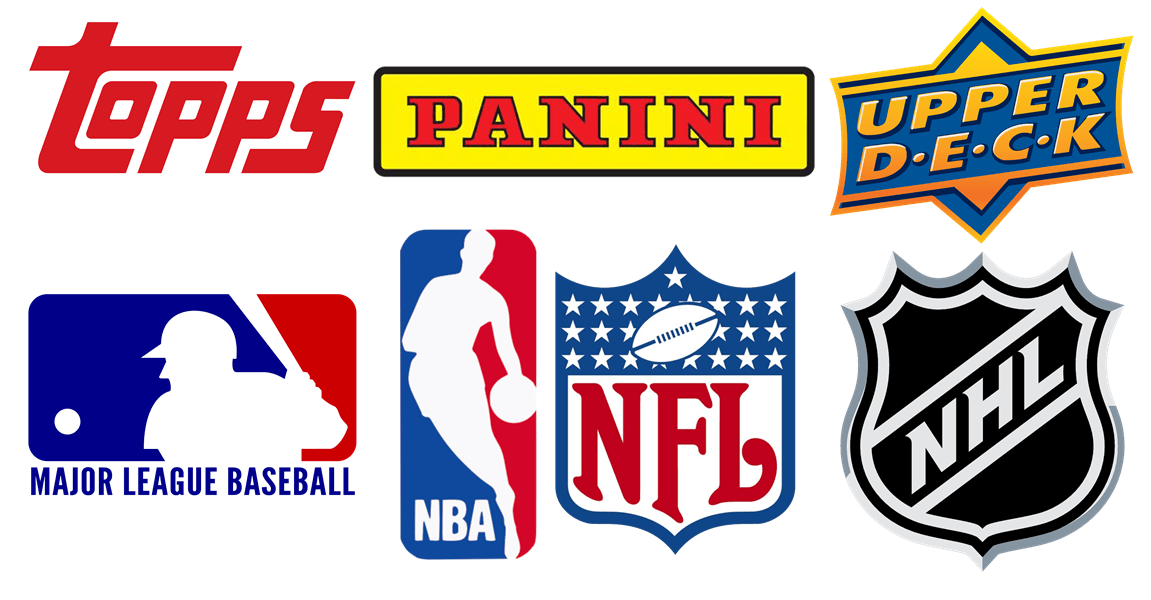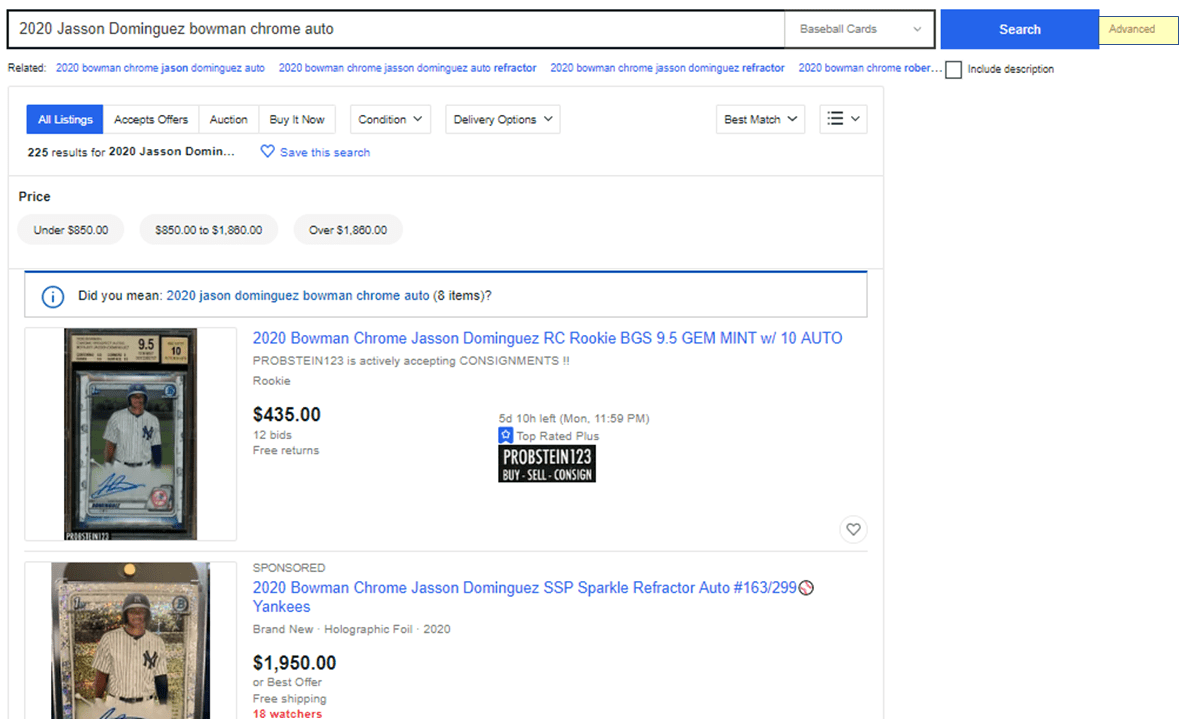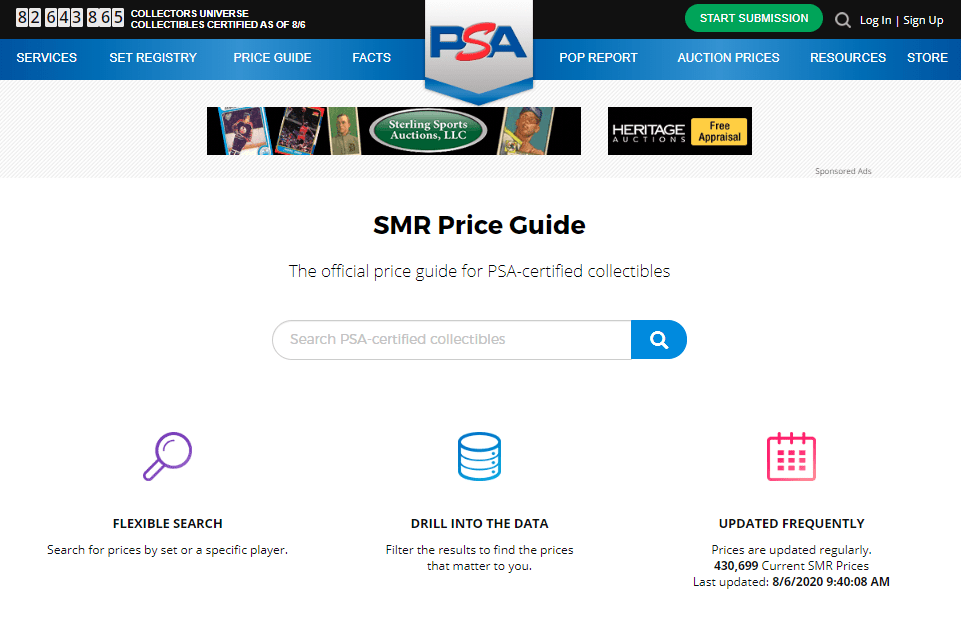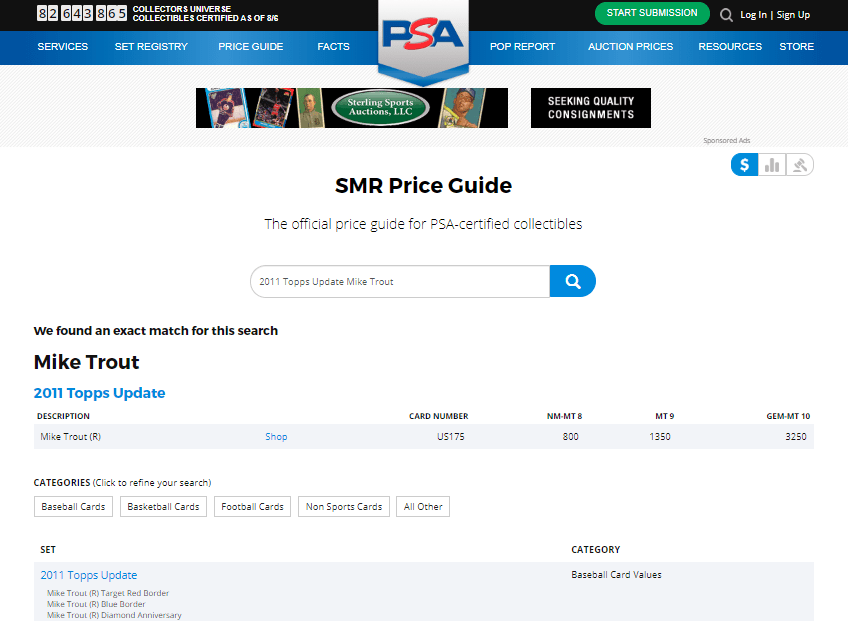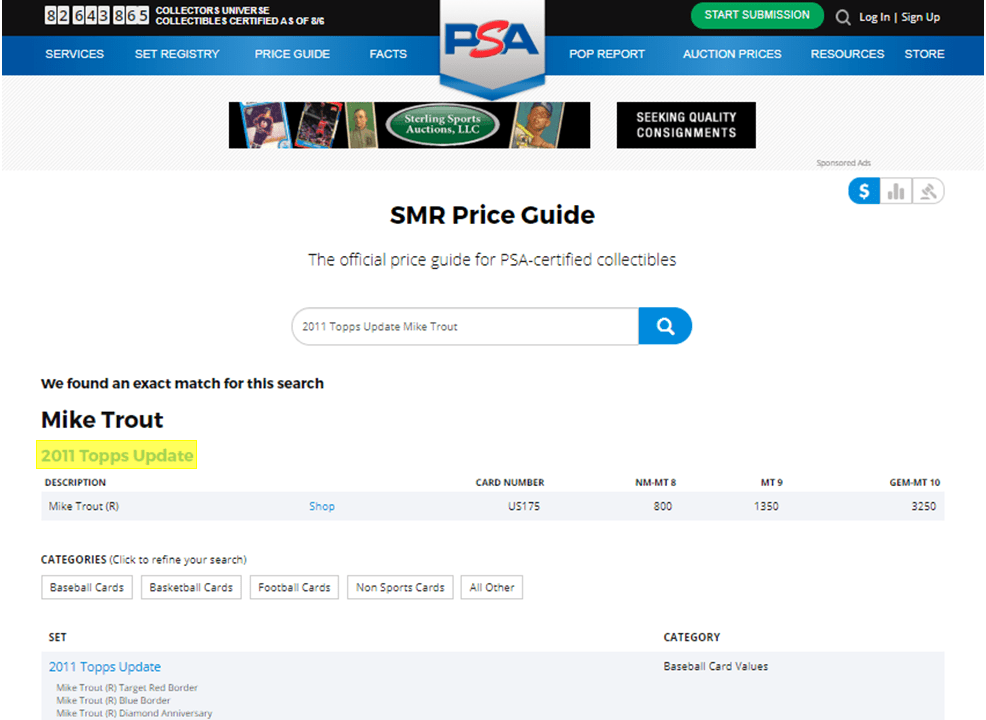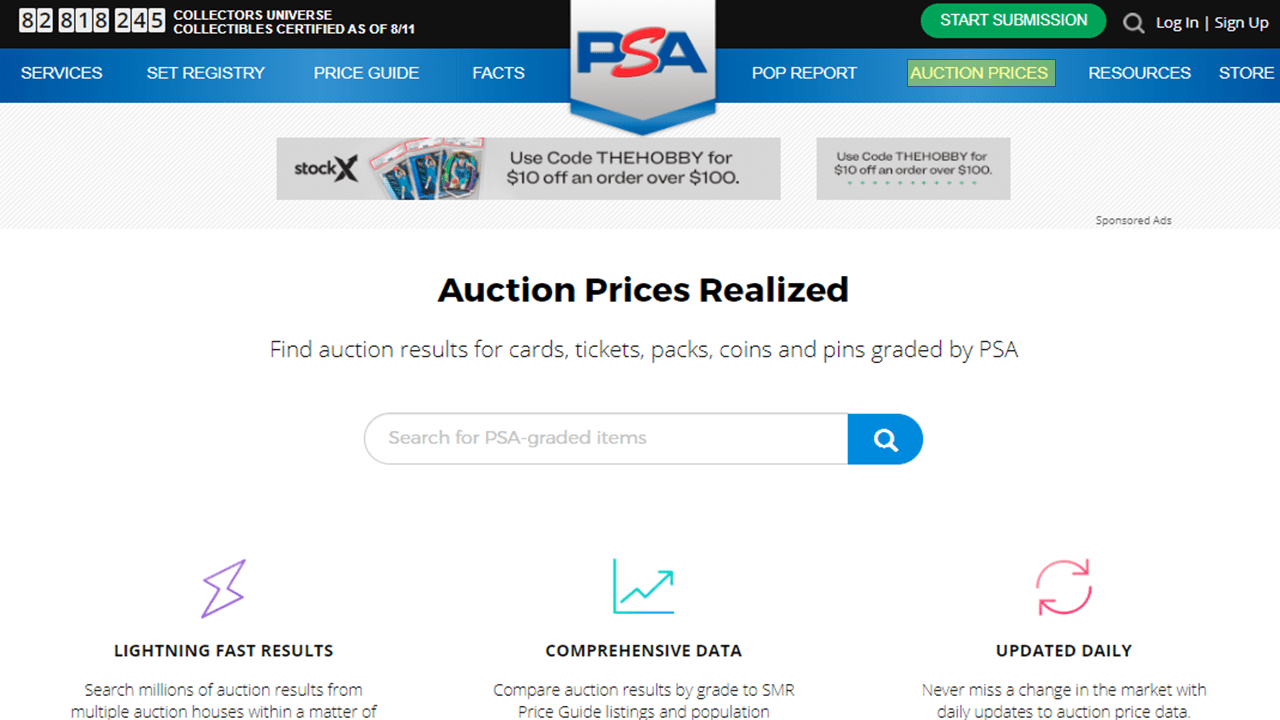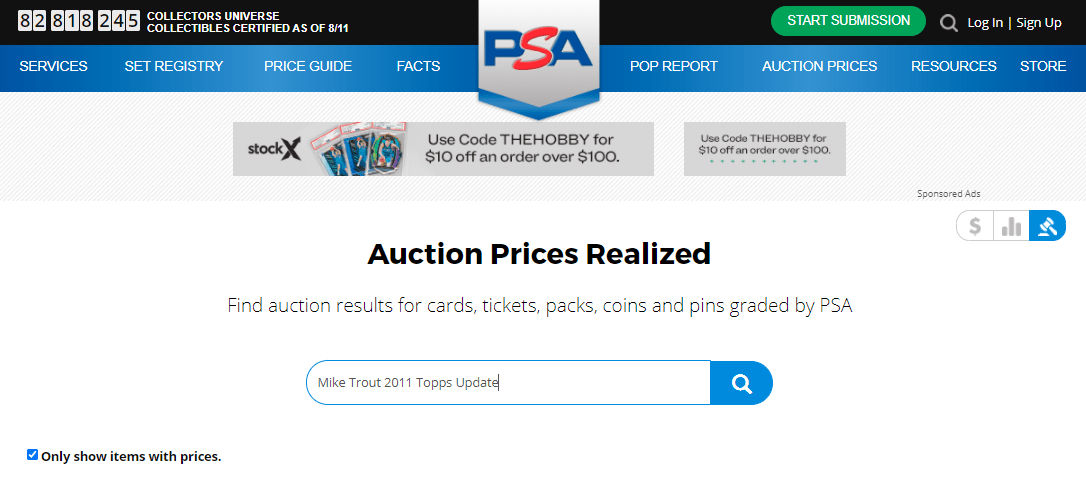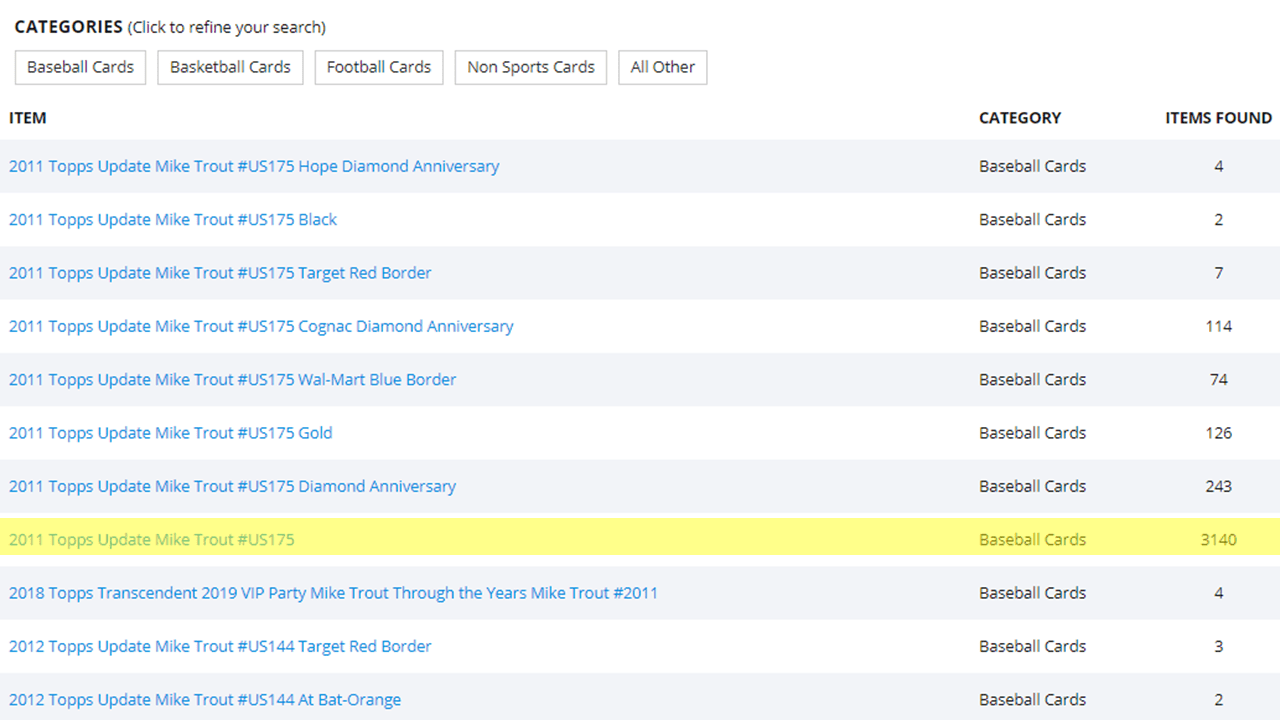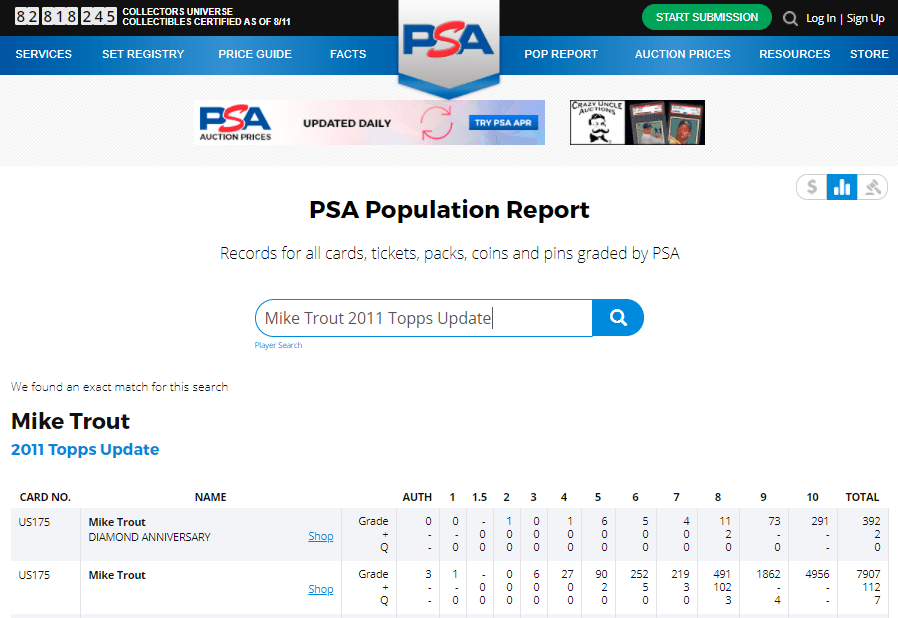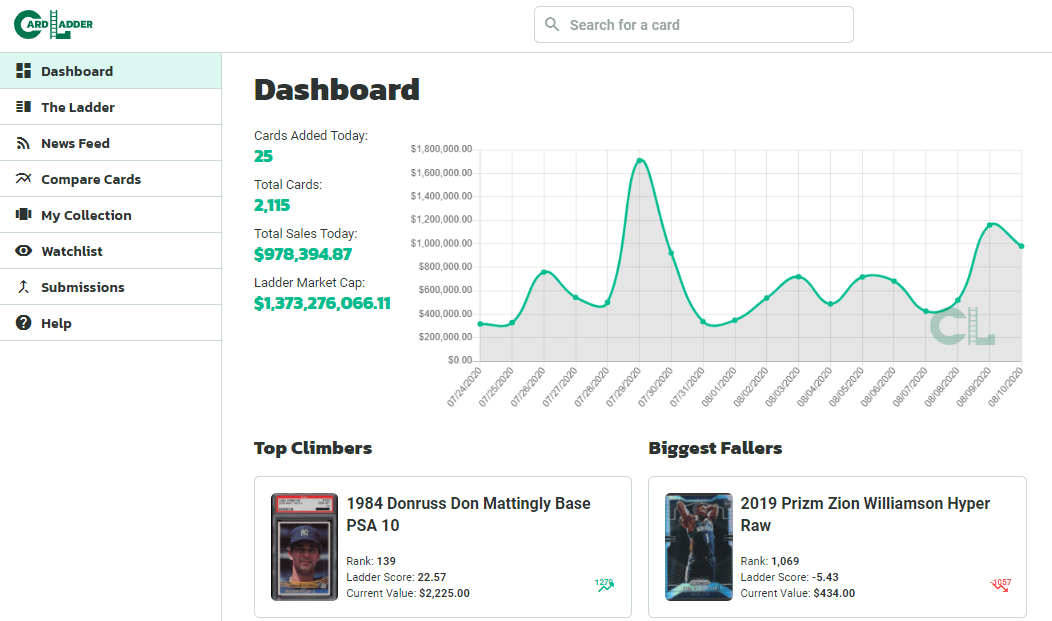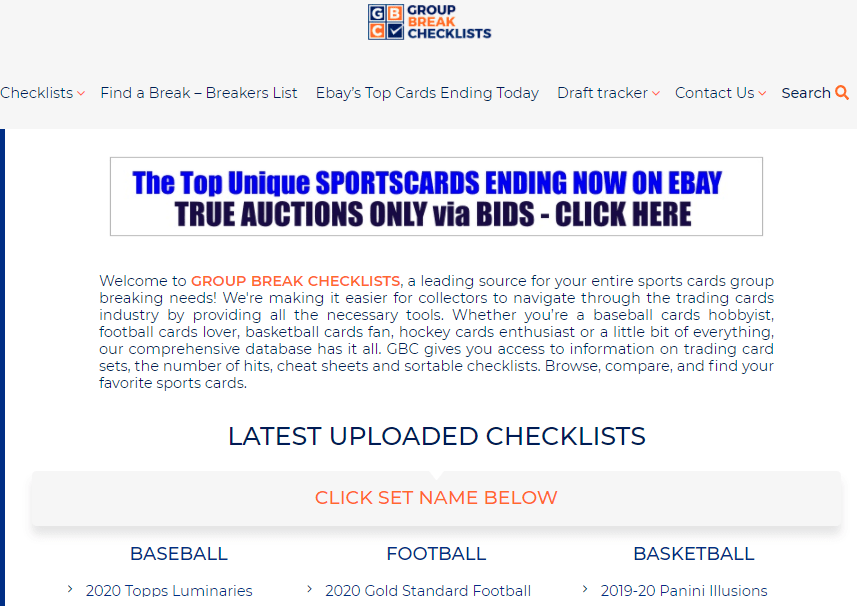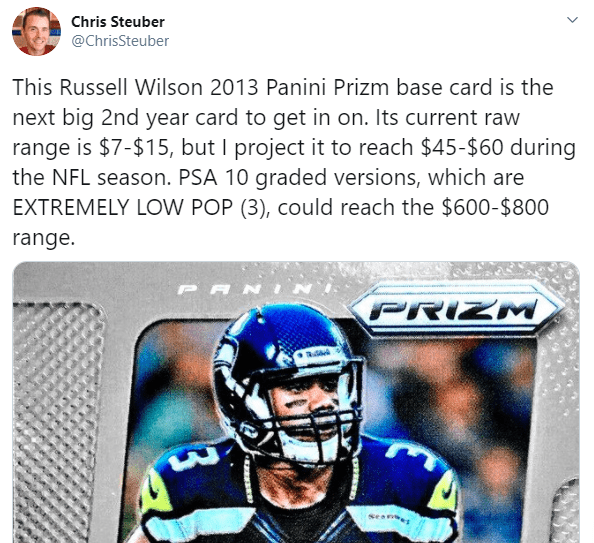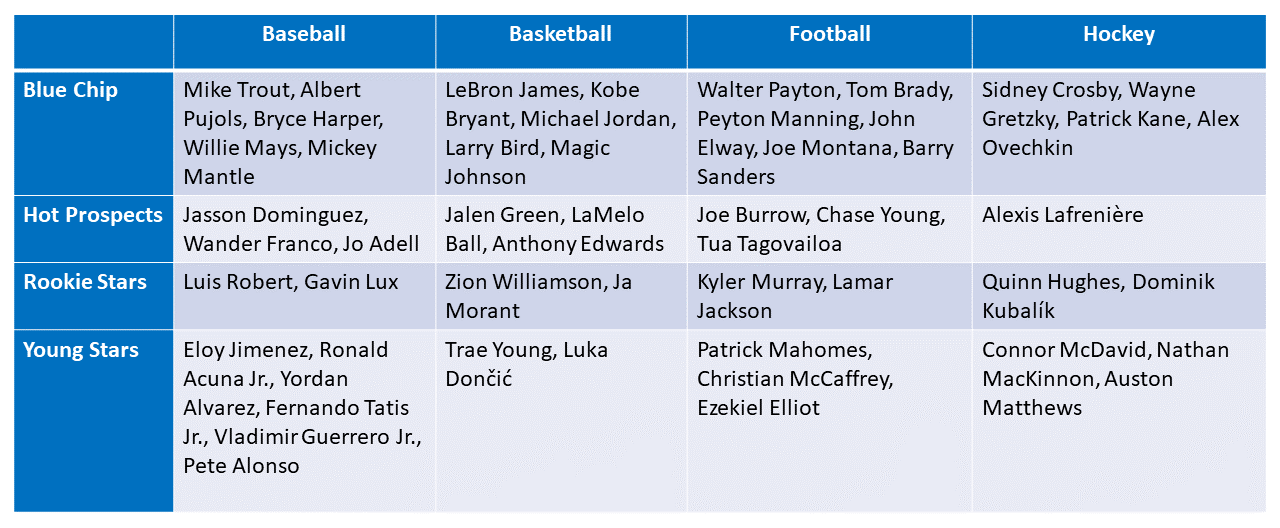Ultimate Guide to Investing, Flipping, Selling Sports Cards – The current state of the sports card and collectibles market is red hot 🔥. Various factors have combined to create the “perfect storm” resulting in unprecedented demand that far exceeds supply. Regardless of the commodity involved, whenever this situation occurs it results in a flood of interest and new money entering the market. It is no different in sports cards.
This guide, will provide you with the details necessary to make educated and informed decisions as it relates to investing, flipping and selling sports cards. However, this is only a guide and we make no guarantees as to the return on your investment.
Topics covered in this Ultimate Guide to Investing, Flipping, Selling Sports Cards include:
- The Current Market – How Did We Get Here?
- Card Types – Understanding the Modern Sports Card
- The Importance of Rookie Cards
- Defining Goals – How to Set and Execute Effectively
- Understanding the Secondary Markets
- Understanding and Researching Card Values
- Understanding Grading
- Understanding Population Reports
- Additional Tools, Tips, Tricks
- Blue Chip Players, Hot Prospects, Rookie Stars
What’s the difference?
The three terms, investing, flipping and selling, may, at first glance, seem synonymous with one another. However, for the purposes of this guide, we define each as the following.
- Investing – A long-term strategy focused on maximizing profits and return on investment.
- Flipping – A short-term strategy focused on making quick money based on a player’s performance, media attention or other factors that can quickly influence price fluctuations.
- Selling – The process and options for how one goes about turning cards into cash.
Ultimate Guide to Investing, Flipping, Selling Sports Cards: The Current Market – How Did We Get Here?
The market for sports cards was already in a growth curve prior to the COVID-19 pandemic. There were several reasons that contributed to the exponential growth the hobby experienced, primary among them being:
- A generation of collectors (40-50-somethings) returning to the hobby with disposable income
- The advent of group case breaking (a method of selling cards where the cost is divided between a group of people)
- The parallels with sports betting (purchasing a pack of cards with the potential of pulling a card worth thousands of dollars results in a similar feeling gamblers experience when betting traditionally on sports)
- International demand, especially for basketball and soccer. As other country’s economies improved across Europe and Asia, so has the discretionary income of many of its citizens most passionate sports fans
- Influx of high-profile, social media influencers and young entrepreneurs.
COVID Impact
When much of the world sheltered-in-place as a result of the COVID-19 pandemic, a couple of interesting things occurred that further contributed to the growth experienced in the sports card market.
- People found themselves with a lot of time on their hands
- Sports cards replaced sports. With all the major sports leagues shut down, people started taking a stroll down memory lane and reliving their youth through sports cards long tucked away in Mom’s attic
- Those same people started poking around the Internet and found a thriving sports card market and community
- ESPN’s airing of the documentary, “The Last Dance” reminded the world of MJ’s dominance and introduced a new generation of basketball fans, including artists and sneaker heads to His Airness’ greatness.
- Sports card stories started hitting the mainstream media, in terms of growing interest and monetary value 💲.
Combine all of these factors with those outlined previously and you have a sports card market the likes of which has never been seen in the hobby.
Ultimate Guide to Investing, Flipping, Selling Sports Cards: Card Types – Understanding the Modern Sports Card
A lot has changed in the hobby of collecting sports cards in the last 20 years. There was once a time when multiple manufactures produced cards for various sports; this practice is a thing of the past, having been replaced by exclusive licensing.
The creation of new card stock and substrates have combined with technology innovations in printing to create some amazing looking cards. Autographed versions and those containing game-used or player-worn materials like jerseys and shoes are also commonplace.
Exclusive Licensees
The following companies produce/manufacture trading cards for the various sports leagues.
- Topps – MLB Baseball Cards
- Panini – NBA Basketball Cards, NFL Football Cards
- Upper Deck – NHL Hockey Cards
However, this can be confusing to new and returning collectors. An additional company, Leaf Trading Cards, currently manufactures trading cards of all sports. However, their licensing is with the individual players and not the professional league and/or players’ association for which they are affiliated.
Additionally, Panini America holds licenses with U.S.A. Baseball and the Major League Baseball Player’s Association. This means that they can produce baseball cards of current professional MLB players, but they cannot depict them in their licensed uniforms or by their licensed team moniker, i.e. “Yankees”.
Jargon, Lingo, Vernacular, Terminology
With the advances in printing technology and manufacturer designs, a whole new terminology has evolved in the hobby. We highly encourage you to checkout our Glossary of Sports Cards Terms and Definitions to learn more. However, for the purposes of of this guide to investing, flipping, selling sports cards, it is important to understand a few key terms.
Refractor: A card that utilizes a printing technology that produces a visual effect that refracts and disperses light in a manner that produces a prism or rainbow-like effect. The process has become very popular with modern trading card manufactures as a result of increased demand for these types of cards from collectors. Topps was the first trading card company to utilize this dynamic printing process.
This term is interchangeable with words used by other trading card manufactures to describe similar types of cards. Panini America refers to these cards as Prizms and Leaf Trading Cards refers to them as Prisms.
Parallel: A card that is similar in design to its counterpart from a base set but offers a distinguishing quality. This can be in the former of border color, texture, card material, printing technology employed among other characteristics.
Refractors, Prizms and Prisms are almost always parallels of a “regular” card in a set/product.
Manufactured Scarcity
To help combat the supply vs demand equation, sports card manufactures now utilize a variety of parallels within each product. The purpose for this is to add production capacity while still maintaining collectibility. The lack of this type of card in the late 1980s and early ’90s resulted in what is now widely referred to as the “junk wax era”, where the volume of cards in the market exceeded demand and the values plummeted drastically.
Enter Refractors and Prizms. By producing alternate versions of a card, some of which are serial numbered to various and specific quantities, collectors now have many options to chase and collect.
We will cover some additional terms in the next section.
Ultimate Guide to Investing, Flipping, Selling Sports Cards – The Importance of Rookie Cards
A rookie card, by definition, is a player’s first officially licensed trading card after making the roster for one of the four major sports (MLB, NBA, NFL, NHL) professional teams. You will often see cards of this type designated with the abbreviation, “RC”. In most cases, a player’s rookie card is his most desirable and carries the greatest value. This is very simple when it comes to players in the NBA, NFL and NHL. The subject gets a little trickier with regards to MLB.
For baseball card collectors however, there are typically cards issued of a player, prior to his making an MLB teams’ 25-man or 40-man roster. The ones to pay specific attention to are that player’s Bowman Chrome autographs. Despite not technically being a rookie card, but instead a prospect card, Bowman Chrome autographs and Refractors, as mentioned previously, carry a significant premium value over the player’s actual rookie card.
For an example, let’s look at Los Angeles Angels superstar, Mike Trout. His officially designated rookie card was issued in 2011 Topps Update Series Baseball. Examples of this card have sold for a wide range of values depending on if the card is raw or graded*. Raw examples sell anywhere from $500-$1,000 and examples graded in a 10 can sell for several thousands.
Now compare this to the prices realized for Trout’s most desirable card, his 2009 Bowman Chrome Draft Prospects autograph. This card routinely sells for tens of thousands of dollars. Low numbered parallels have sold for hundreds of thousands and his 1-of-1 SuperFractor is worth over $1M.
* Graded cards are cards that have been assigned a numerical value as it relates to their physical condition on a scale of 1 to 10, with 10 being a card in pristine or mint condition. A raw card is one that has not been graded. We will discuss graded cards in more detail later in this guide in the Understanding Grading section.
So Many Rookie Cards
Long gone are the days where a player has a single rookie card. It is one of the factors that plays into the continued popularity of collecting vintage cards, the simplicity. In the modern sports card market, however, a player may have 20, 30 or more rookie cards. Why? Each trading card manufacturer produces multiple products for their respective sport each year. Rookies are included in each one resulting in multiple rookie cards.
So, how do you know which ones to buy? While there are certainly several nuanced factors that go into that decision, here are some insights into the current market regarding popularity and value of specific brands in each sport. For the purposes of this guide, we will only be looking at league licensed sports cards.
However, this is by no means absolute. There is plenty of opportunity to make money on cards from other brands. The following is just a good place to start when it comes to learning the ins and outs of investing, flipping and selling sports cards.
Ultimate Guide to Investing, Flipping, Selling Sports Cards: Defining Goals – How to Set and Execute Effectively
As with any business venture or investment having goals and knowing the tactics to use to reach those goals is paramount to success. Again, there are NO guarantees for making a return on your investment. All you can do is set your goals and educate yourself on the best means to go about achieving those goals.
Setting a Budget
Sports cards can be expensive. We live in an era where some brands cost thousands of dollars. The thrill of the chase and the gambling aspect involved in the modern sports card era can quickly result in spending beyond one’s means. DON’T! Plain and simple.
At the end of the day this is still a hobby; a recreational pastime activity designed to bring joy, relaxation and contentment. Spending more money than you can afford will quickly negate all of those passive benefits.
Before you dive in and start buying sports cards, set a budget. What that amount should be will be defined by what you can afford knowing that you may not make any profit at all or in a worst case scenario, actually lose money. A good way to set a budget amount is to define what you would be willing to spend on an entertainment activity, knowing that when the entertainment is over, you’re out of money and it’s time to go home.
Next, you need to define your goals.
- Are you simply looking to make money to feed your hobby, leaving your personal finances untapped and creating a self-perpetuating income stream?
- Are you looking to sports cards as an alternative investment strategy to stocks, bonds and other traditional financial instruments?
- A little bit of both?
- Something entirely different?
Only you can decide what those goals should be. Don’t get caught up in the hype and hysteria that comes along with “the next big thing”. In the modern sports card market that can be a highly touted prospect, a manufacturer exclusive online offering, a bulk liquidation find on Craigslist or any of a number of things that can distract you from your goals. Make a plan and stick to it.
Ultimate Guide to Investing, Flipping, Selling Sports Cards: Understanding the Secondary Markets
The age of the Internet has ushered in a whole new way to buy and sell sports cards. No longer dependent strictly on your local card shop, you can now sit in the comfort of your home and shop and sell on a handful of highly-trafficked, reputable websites. Most notably among these are:
eBay – The oldest and largest platform for buying/selling sports cards. The amount of traffic eBay receives is unparalleled making it an attractive option for purchasing and selling.
COMC – Formerly known as Check Out My Cards, was a game-changer when it entered the market about a decade ago. Their platform lets you hold an inventory of cards that you can make available for sale, have held in your account or have directly shipped to take physical delivery.
Savvy collectors have been able to flip cards, at a profit, within the platform simply based on a player having a good game, or being undervalued. When a good player is stuck in a small market but has a big game on the road in a large market, that player gets more attention and their card values often increase. We know of some collectors that will look at the NBA schedule when released and set calendar reminders for themselves to look for such players the day before a large market road game.
Beckett Marketplace – Carries an enormous inventory of over 30M cards. A well-know, reliable platform with easy search functionality.
StockX – A recent newcomer to the market. This site was originally founded for the purpose of flipping sneakers but as mentioned earlier, the model quickly translated to sports cards and now provides a fluid interface in which to buy and sell cards.
Sportlots – A tried and true eBay alternative, you can find plenty of affordable singles to flip. Think of it like the online version of your local card shop or card show’s dollar boxes. Taking the time to sift through inventory can result in finding some diamonds in the rough. We know collectors who use this platform, or physically search, dime, quarter and dollar boxes for under-valued cards on a regular basis and are always turning a quick profit to feed their hobby budget.
The Pit – An early adopter of being able to buy and sell sports cards like stocks. The site includes access to numerous metrics and indicators associated with the gains and losses of particular cards over time.
StarStock – The latest newcomer to the sport card market that defines itself as “The Stock Market for Sports Cards”. The site features a robust trading platform and personalized portfolio that allows for instant ownership of cards purchased.
Ultimate Guide to Investing, Flipping, Selling Sports Cards: Understanding and Researching Card Values
eBay Pricing
Like any commodity, the value of sports cards can fluctuate quickly. Thankfully, eBay provides a function that allows you to search and find the recent sale prices for any card listed on the site. This is by far and away the most effective method of determining a baseline for a card’s current value.
The process is simple, just follow it step-by-step. Let’s find out what top Yankees prospect, Jasson Dominguez, Bowman Chrome Prospect Autographs are currently selling for at the moment.
Step #1
Enter the year, player, card brand and type as highlighted in the search field as shown in the image below and then click the blue “Search” button.
Step #2
Click on the highlighted “Advanced” link.
Step #3
Check, the “Sold” box and click the blue “Search” button.
Step #4
Mouse over the “Sort” field to display the drop down menu and select Price: Highest First
Step #5
This will sort the most recent sales in order highest to lowest. From there you drill down for more detail like a specific Refractor or card grade.
Because sports cards sell on a wide array of secondary market platforms, as explained in the previous section, the realized prices on eBay aren’t absolute. However, they do provide a very strong indicator of current market value within a given price range.
PSA Graded Card Pricing – Average Pricing
PSA offers a couple of simple to use pricing tools. One allows you to quickly and easily find the current average price of a specific card in a specific grade. The other allows you to view realized auction prices, across multiple secondary market platforms and auctions houses.
Step #1
Click on the “Price Guide” button highlighted below.
Step #2
Enter the specifics of the car you are looking for in the search field.
 Step #3
Step #3
Results will appear instantly.
Step #4
Click on the set highlighted below.
Step #5
The current average sale prices in the top three grades are displayed.
Back to Top
Back to Top
PSA Graded Card Pricing – Auction Prices Realized
Step #1
Click on the “Auction Prices” link highlighted below.
Step #2
Enter specifics in the search field, i.e. – player name, year, brand, set.
Step #3
Scroll through search results for specific card, in this case the regular version of Mike Trout’s 2011 Topps Update baseball card.
Step #4
Click on specific card to view current market data from recent and historical auction sales.
Step #5
Click on the “Auction Results” link highlighted about to view detailed specifics of individual sales.
Being armed with current and accurate pricing data will help you determine values for both buying and selling cards from, and for, your own hobby portfolio.
Ultimate Guide to Investing, Flipping, Selling Sports Cards: Understanding Grading
The process of grading a card is used to apply a numerical value commiserate to the card’s physical condition. A scale of 1-10 is used and includes half grades indicated by X.5. The examination of the card is performed by a third-party grading company. There are three primary grading companies in the hobby today: Professional Sports Authenticator (PSA), Beckett Grading Services (BGS) and Sports Card Guaranty Corporation (SGC).
Grading standards and definitions may vary slightly from one company to another. However, each employ very similar criteria. The chart below, provides an overview of card grades by company. In addition, the links take you to the grading standards for each company.
Ultimate Guide to Investing, Flipping, Selling Sports Cards: Understanding Population Reports
In addition to condition, rarity and scarcity, of any tangible asset, help determine its price or value. Knowing how to properly use and understand published population reports can help you find hidden gems in the market that may be under-valued or ripe for a price increase.
Population reports are published by each of the grading companies. Their purpose is to provide a real time analysis of the number of a specific card submitted for grading. Additionally, you can view the number of cards that have received a specific grade. Let’s take a look in the screen shots that follow.
Step #1
Click on the “Pop Report” link highlighted below.
Step #2
Enter the specifics of the card you are looking for, again, in this case – Mike Trout 2011 Topps Update.
Step #3
Scroll through search results for the specific card.
Step #4
Review the data.
In this specific case, with regards to Mike Trout’s 2011 Topps Update, base card #US175, the following can be inferred. To date (at the time of this writing) there have been 7,907 of these cards submitted to PSA for grading.
Of those, 112 have received a half-point grade as indicated by the (+) sign. Additionally, of those submitted, seven cards received a grade with some sort of qualifier. This can range from an errant print dot to being slightly off-center for the grade standard.
In total, of the 7,907 cards submitted, 4,956 received a grade of PSA 10. While 1,862 received a PSA 9 and so on.
To determine as close to 100% of the total population report for a specific card, you would have to repeat this process for each of the other grading companies, BGS and SGC.
Ultimate Guide to Investing, Flipping, Selling Sports Cards: Tools, Tips, Tricks
Additional Tools
In addition to the tools already featured in this guide, their is a wealth of information available to help navigate and better understand the sports card market.
Card Ladder – One of the most insightful and easy to navigate tools in the hobby today. The site provides several analytical tools including: 14-day and 90-day pricing trends, a player’s definitive key rookie card, market cap, undervalued cards and more.
PWCC Markeplace – This company was one of the early adopters of and advocates for, providing collectors with concise, market-driven data to fuel, potential, investment opportunities. The modern sports card market being referred to as a tangible asset class may have been originally coined by the company’s founder, Brent Huigens. The company was also the first to utilize a price index similar to the S&P, Dow Jones and NASDAQ.
Group Break Checklists – If you’re looking to buy into a group break, be sure to use this website to determine what cards a player has in a product. Are they in the product at all. Do they have autographs? How many different parallels? What are the parallels numbered to? These questions can all be answered here.
Back to Top
Media – Podcasts, Webcasts, Influencers
The explosion in popularity of the sports card market as an alternative asset class, as spawned numerous podcasts and webcasts dedicated to the practice. In addition, there are several popular social media influencers more than happy to share their opinions and/or expertise on the topic. Some of the more popular include the following.
Podcasts/Webcasts
Social Media Influences
Tips/Tricks
Depending on how long you have been in the hobby, there are several tips and tricks one can use to increase your chances of profitability when it comes to investing, flipping and selling sports cards. Here are a few categorized by Beginner, Intermediate and Advanced.
BEGINNER
Name Misspellings – Try searching eBay for a specific player with their name misspelled. You’d be surprised how many listings you can find with a player’s name misspelled. This often results in less eyeballs watching the card and potentially, resulting in a lower purchase price that you can then relist at a profit.
Examples of searches:
- Zion Williams (Instead of Williamson)
- Jason Dominguez (Instead of his correct first name, Jasson, with two s’s)
- Any player named Brian or Bryan and reversing the spelling
- Etc., Be creative
INTERMEDIATE
Flipping on COMC – Do you know you don’t even need to take physical possession of cards purchased on COMC? This is a great feature because it allows you to keep an inventory and practice the equivalent of day trading. Say you’re watching an NBA game an a young, potential star, like Kyle Kuzma, already has 12 points in the first quarter. You can go onto the COMC website, purchase his cards that fit your aforementioned budget and reprice them at a higher price. You can do this all before halftime when he has 26 points, the talking heads are hyping his play and other investors and flippers try to jump on his cards. However, you’ve already beat them to the punch!
ADVANCED
Resubmitting – Grading, by its very nature, is a highly subjective practice. It is a process subject to human error despite the grading companies best efforts. As a result, sometimes, cards receive a lower grade than they actually should. It is not uncommon for people to purchase graded cards in grades of an 8 or 9, crack the cards out of the slab and resubmit them in hopes of earning a higher grade. You can find several videos on YouTube on how to safely do this without damaging the card.
Ultimate Guide to Investing, Flipping, Selling Sports Cards: Blue Chip Players, Hot Prospects, Rookie Stars
Most players worth investing in for profit can be defined by four different categories: Blue Chip Players, Hot Prospects, Young Stars and Rookie Stars. Here are the differences and a look at just some of the players currently in each category.
Blue Chip – Established veteran superstars, many of whom may be locks to be inducted into their respective sports’ Hall of Fame. Also includes top-tiered, retired greats.
Hot Prospects – The next generation of potential future stars that have not yet played at the professional or major league level.
Rookie Stars – First year players that play like established stars.
Young Stars – Typically 2nd, 3rd or 4th year players already making a big impact for their team.
Ultimate Guide to Investing, Flipping, Selling Sports Cards
- 2023 Leaf Magnificence Multi-Sport Trading Cards Checklist - April 16, 2024
- 2024 Craniacs Trading Cards Series 1 - April 16, 2024
- 2024 Upper Deck Black Diamond AEW Trading Cards - April 16, 2024

